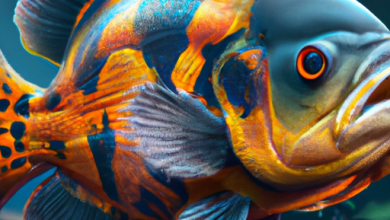Guidelines for Stocking Your Aquarium

hoosing the Right Fish for Your Aquarium
Choosing the right fish for your aquarium is an important step in creating a healthy and balanced environment. The type of fish you choose will depend on the size of your aquarium, the type of environment you want to create, and your budget.
When selecting fish for your aquarium, it is important to consider the size of the tank. Different species of fish require different amounts of space, and overcrowding can lead to stress and disease. Generally, larger tanks are better suited larger fish, while smaller tanks are better for fish. It is also important to consider the water temperature and pH level of the tank when selecting fish; some species are more tolerant of varying water conditions than others.
The type of environment you want to create will also influence the types of fish you select. If you want a peaceful tank, then select fish that are known to be peaceful and avoid aggressive species. If you want a more active tank, then choose fish that are known to be active swimmers.
Finally, budget is an important factor when selecting fish for your aquarium. Some species are more expensive than others, so it is important to consider how much money you can spend on fish. Additionally, some species require more specialized care than others, so it is important to consider if you have the time and resources necessary to properly care for certain types of fish.
In conclusion, when selecting fish for your aquarium, it is important to consider the size of the tank, the type
Understanding Aquarium Water Chemistry
Understanding aquarium water chemistry is essential for the successful maintenance of a healthy aquarium. Aquarium water chemistry refers to the chemical composition of the water, which includes elements such as pH, alkalinity, hardnessrates, and phosphates these elements and their interactions is important for maintaining a healthy aquarium environment.
The pH of the water is a measure of its acidity or alkalinity. It is expressed on a scale from 0 to 14, with 7 being neutral. Generally, freshwater aquariums should have a pH between 6.5 and 8.0, while saltwater aquariums should have a pH between 8.0 and 8.4. If the pH is too low or too high, it can cause stress to the inhabitants of the aquarium and can lead to disease.
Alkalinity is the measure of carbonates and bicarbonates in the water. It helps to stabilize the pH of the water and should be kept between 80-120 ppm (parts per million). Low alkalinity can cause rapid pH fluctuations, while high alkalinity can cause difficulty in maintaining a stable pH.
Hardness is the measure of calcium and magnesium in the water. It should be kept between 5-20 dH (degrees hardness). Low hardness can cause difficulty in maintaining a stable pH, while high hardness can cause problems with fish health and plant growth.
Nitrates and phosphates are two important nutrients in aquariums. Nit
Setting Up the Aquarium Filter System
Setting up an aquarium filter system is a crucial step in creating a healthy and safe environment for your fish. It is important to understand the basics of how the system works in order to ensure proper maintenance and care.
The first step is to choose the right filter for your tank. There are several types of filters available, including mechanical, biological, and chemical filters. Mechanical filters use physical media such as sponges or pads to trap particles and debris from the water. Biological filters use beneficial bacteria to break down organic matter and pollutants. Chemical filters use activated carbon or other substances to remove toxins from the water.
Once you have chosen the right filter for your tank, you need to install it. This involves connecting the filter to the power source, attaching the intake tube, and placing the filter in the aquarium. It is important to make sure that the filter is securely attached and that all of the connections are tight.
Next, you need to set up the media in the filter. This includes adding sponges, pads, or other materials that will trap particles and debris from the water. For biological filters, you will need to add beneficial bacteria to help break down organic matter and pollutants. For chemical filters, you will need to add activated carbon or other substances to remove toxins from the water.
Once the filter is installed and set up, it is important to maintain it regularly. This includes cleaning and replacing media as needed, as well as testing the water
Establishing a Healthy Aquarium Environment
Establishing a healthy aquarium environment is essential for the wellbeing of the fish and other aquatic life. It is important to create an environment that mimics the natural habitat of the animals, while also providing the necessary filtration and oxygenation to keep the water clean and healthy.
The first step in creating a healthy aquarium environment is to choose the right tank size for the species of fish you plan to keep. It is important to ensure that the tank is not overcrowded, as this can lead to stress and disease. The tank should also have enough room for the fish to swim freely and explore their environment.
The next step is to choose the right substrate. Substrate is the material that lines the bottom of the tank, and it can range from gravel to sand, depending on the species of fish. The substrate should be chosen carefully, as it will affect the pH levels of the water and provide a habitat for beneficial bacteria.
The water temperature is also an important factor in creating a healthy aquarium environment. Different species of fish require different temperatures, so it is important to research the ideal temperature for your species before setting up your tank. Additionally, you should also consider installing a heater or chiller to maintain a consistent temperature.
Filtration is another important element of creating a healthy aquarium environment. A good filter will help keep the water clean by removing debris and toxins from the water. It is important to choose a filter that is appropriate
Maintaining Proper Aquarium Maintenance
Maintaining proper aquarium maintenance is essential for the health and well-being of the inhabitants of the tank. Aquariums are delicate ecosystems that require regular care and attention in order to remain healthy. Without proper maintenance, aquariums can quickly become overrun with algae, uneaten food, and other debris, leading to a decrease in water quality and the death of the fish and other aquatic life.
The first step in maintaining an aquarium is to regularly change the water. This should be done at least once a week, or more often if the tank is heavily populated. When changing the water, it is important to use a siphon to remove any debris that may have accumulated on the bottom of the tank. Additionally, it is important to use a water conditioner to remove any chlorine or other chemicals that may be present in tap water.
In addition to changing the water, it is important to clean the tank regularly. This includes scrubbing the walls and decorations with an algae pad or brush. It is also important to clean the filter regularly, as this will help to keep the water clean and free of debris.
Finally, it is important to feed the fish in a responsible manner. Overfeeding can lead to an increase in waste and a decrease in water quality. It is important to feed only as much as the fish can consume within a few minutes. Additionally, it is important to provide a variety of foods so that the fish receive a balanced diet.
Excerpt
When stocking your aquarium, it is important to consider the size of the tank, the type of fish, and the compatibility of the species. Research the type of fish you want to keep to ensure that they are suitable for your tank size and that they will be compatible with other species you plan to keep.



